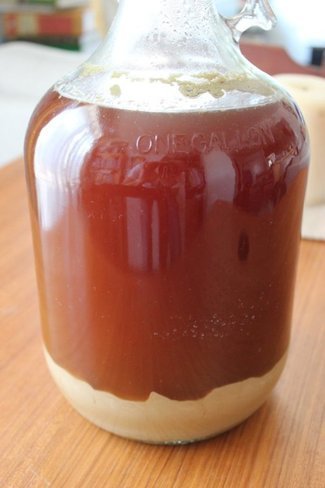If you're a facebook fan you'll know that I started chiseling away at my six-pack a couple weeks ago. I’m not talking about a Mike “The Situation” six-pack, I’m talking about beer. About a year ago I started home-brewing on an ultra-micro scale. In fact, it would be difficult to brew at a smaller scale. I brew one gallon at time, which equates to about 6-8 beers per batch. It’s not that I don’t want brew more beer, it’s that we live in a 600 sq ft apartment and don’t have room. My closet is already full of canning equipment, preserved jars of everything, sacks of espresso beans, liquores of who knows what, and oh yeah, my clothes. A 2 sq. ft. corner holds a case of aging beers, two one gallon carboys (one fermenting, one dry-hopping) and a little space for the blow-off tube. In that amount of space I get a six-pack every week.
Brewing Without Dorking-Out
I use simple brewing instructions that are widely applicable/fungible across a range of beers. Like any craft, you can totally nerd-out on brewing. I don’t get bogged down in the details or home-brewing geekiness too much though. The goal is good beer and I don’t care too much about the ABV, IBU, SG, PH or any other acronyms. I like using Brooklyn Brew Shop’s website for instructions. Use the dropdown menu on the site to find a beer similar to the one you're brewing and use those instructions. There are PDFs for a variety of brew-types and there’s a good video too. The site also lists the equipment you’ll need, which you can order as a kit online, or go to a local shop and buy everything.
For recipes I like to use a variety of different forums. Recently my favorite has been Tasty Brew. Home Brew Talk, The Brewing Network, and Northern Brewer are all excellent too. All you really need is to think of a beer you like and find a similar recipe that gets good feedback. For instance, I like red ales, so I read through a bunch of red ales and found a couple I liked. Then I sort of mixed and matched ideas between them all and came up with my own blend. Once you have a breakdown of the ingredients and some idea for timing you can meld it with the instructions from Brooklyn Brew Shop’s site pretty easily.
After you have your equipment, ingredients and instructions ready, go brew a batch. I like to get enough of everything to brew 4-5 batches of the same beer over the course of 4-5 weeks. That way I can take notes and tweak certain things and then compare the various outcomes. More importantly, if you brew similar beers back-to-back you can re-use the yeast, which is a big cost savings when yeast costs $3-$5 a pack.
 Red ale done dry-hopping, ready for bottlingThe Weekly Six-Pack
Red ale done dry-hopping, ready for bottlingThe Weekly Six-Pack
If you want a six-pack every week, here’s where it gets a little tricky and slightly technical for the newbie. After the first batch ferments for a week you’ll want to get another batch brewing. After you rack the original brew into the dry-hopping carboy make sure to save the original yeast. Rack the new brew in the original carboy with the original yeast and re-use the yeast (about 4-5 times before it needs replacing). It helps to brew similar beers because different yeasts are used for different beers and mixing and matching doesn't always turn out so well.
After the second week you’ll want to bottle the dry-hopped beers, transfer the second brew to the dry-hopping carboy and brew another batch to put in the yeast carboy. You can repeat that sequence all year long.
 Swing-top bottles ready for glory
Swing-top bottles ready for glory
Schedule in a nutshell:
Starting Date: Brew Batch #1
Week One: Dry-Hop Batch #1, Brew Batch #2
Week Two: Bottle Batch #1, Dry-Hop Batch #2, Brew Batch #3
Week Three: Bottle Batch #2, Dry-Hop Batch #3, Brew Batch #4
Week Four: Drink Batch #1, Bottle Batch #3, Dry-hop Batch #4, Brew Batch #5
Rinse and repeat all fall, winter and spring. I only brew when it’s consistently 75 degrees or below outside because I don’t have a temperate aging space for the beers and our apartment gets really hot in the summer, but if you have a cellar or live in Greenland you could do this all year.
To get a finished beer it takes 4 weeks. The time commitment each week is about 4 hours. I start right at the end of the afternoon football games on Sunday, so I brew from the end of one game through the beginning of the Sunday night game. Works out really well. There’s plenty of down time, so I can relax and watch a bit of the game. I guess that's one benefit of our kitchen/living room combo.
I’ve found that you can get some really good beers this way and it can run anywhere from 30c to $2 per bottle depending on where you get your hops, yeast, grains, etc and what types/quantity you use of each. If you’re scrappy and use stuff you have on-hand you can probably get a good kit together for under $40 or $50. Using self-locking bottle tops (i.e. Grolsch bottles) will save you the cost of bottle caps, a bottle capper ($20) and the associated waste. Re-using yeast is a big money saver. Growing your own hops and/or grains would also be a huge saver. My Chinook hop plant is back up to about 15” tall, so I’m hoping to avoid spider mites and get some yield later this spring, we’ll see!
Now you’ve got a weekly rotation and pretty soon you’ll have a six-pack ready to drink every week and you won’t need a ton of space or brewing experience to do it.


